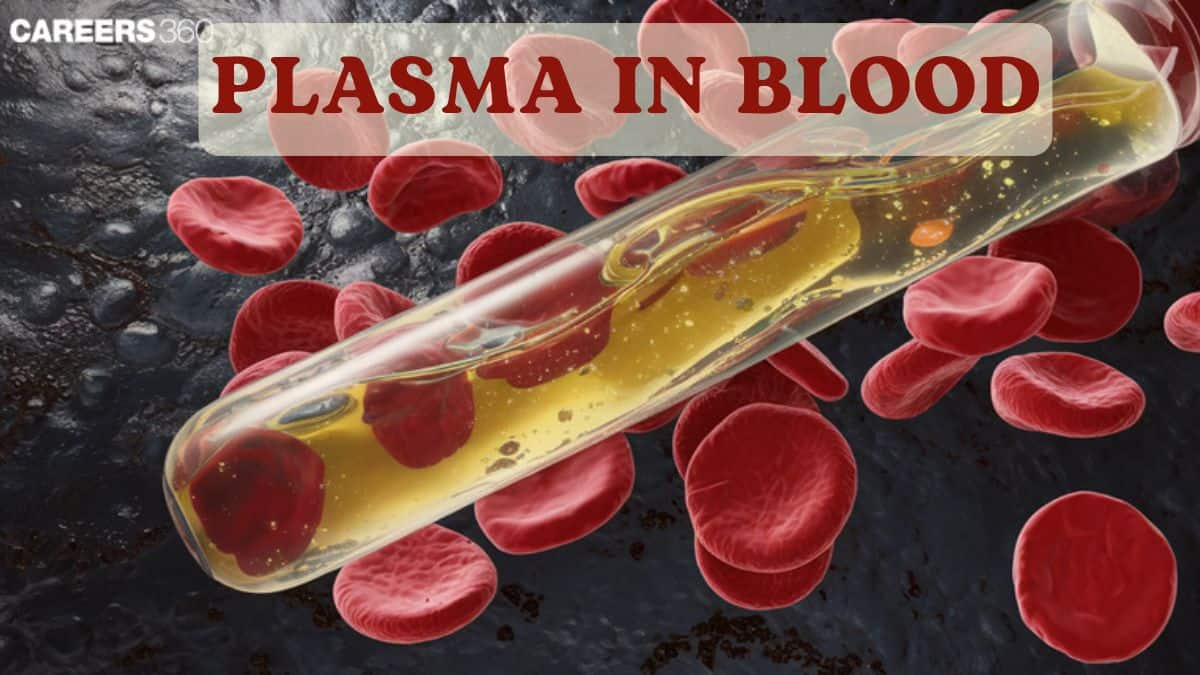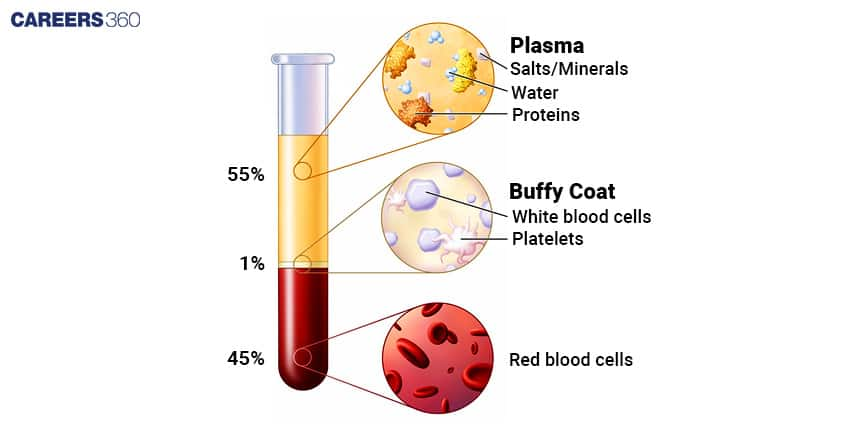Plasma In Blood
Plasma is the clear, yellowish fluid that makes up about 55% of blood, carrying nutrients, hormones, and waste products. It also regulates blood pressure, pH, and electrolytes while supporting clotting and immunity. A key Class 11 Biology and NEET topic in blood physiology.
This Story also Contains
- What is Blood Plasma?
- Composition of Blood Plasma
- Functions of Blood Plasma
- Blood Plasma and Homeostasis
- Clinical Relevance of Blood Plasma
- Plasma in Blood NEET MCQs (With Answers & Explanations)
- Recommended Video On 'Blood Plasma'

What is Blood Plasma?
Blood has two components: blood plasma and formed elements, which are cells. Blood is about 45% formed elements and 55% blood plasma. If a sample of blood is centrifuged in a small glass tube, the cells (which are more dense) sink to the bottom of the tube while the plasma (which is less dense) forms a layer on top.
More than 99% of the formed elements are red blood cells (RBCs). White blood cells (WBCs) and platelets occupy less than 1% of the formed elements. Because they are less dense than red blood cells but more dense than blood plasma, they form a very thin buffy coat layer between the packed RBCs and plasma.
Blood plasma in the body serves to assist other important functions of the body, such as the transportation of nutrients, hormones, and waste materials. It also assists in the regulation of blood volume and blood pressure. Plasma also plays a role in blood clotting and immune responses.

Composition of Blood Plasma
Blood plasma is a chemically complex suspension, with a wide range of elements contributing to the overall function of blood plasma.
The major components of plasma are:
Water (90%)
Functions as the primary solvent, thus enabling the dissolution of the other components.
Facilitates the ability to convey nutrients, hormones, and waste products.
Plasma Proteins (Albumin, Globulins, Fibrinogen)
Plasma proteins are composed of:
Albumins
54% of the plasma proteins
Maintain osmotic pressure to prevent fluids from leaving the blood vessels.
Carry hormones, vitamins, and drugs.
Globulins
38% of the plasma proteins
Contains antibodies (immunoglobulins) that help in the immune defence
Carry lipids and hormones
Fibrinogen
7% of the plasma proteins
Produced in blood clotting and helps in creating the fibrin threads when blood coagulates after an injury to stabilise the blood clots.
Other Solutes (Electrolytes, Wastes, Hormones)
Electrolytes (sodium, potassium, calcium, etc.) which help maintain osmotic pressure and play essential roles in cell functions.
Regulatory substances such as enzymes and hormones
Waste products such as urea, uric acid, creatinine, ammonia and bilirubin.
Functions of Blood Plasma
The different functions of plasma are essential for the maintenance of homeostasis and support of physiological processes.
Transportation of Nutrients, Hormones, and Wastes
Transport of nutrients, hormones, gases (oxygen and carbon dioxide) and waste products
Transports nutrients from the digestive system to the body cells.
Transports hormones from the endocrine glands to target tissues.
Transports waste products to the kidneys and the liver for detoxification.
Transports gases like oxygen which is important in many cellular functions and carbon dioxide which is involved in the regulation of blood pH.
Regulation of Blood Volume and Pressure
Role of albumins in maintaining osmotic pressure
Prevents excess fluid loss by the blood vessels to the tissues.
Helps to balance blood pressure and volume.
Role in Clotting and Immune Response
Plays an essential role in blood clotting.
It is cleaved to form fibrin, leading to the coagulation of blood and preventing bleeding.
Globulins carry antibodies and provide immunity by neutralising pathogens and removing pathogens from the body.
Blood Plasma and Homeostasis
Plasma has a pivotal role in maintaining the internal environment of the body.
Regulation of pH
Plasma proteins may be buffers
This is mainly done by plasma proteins, by buffering out the extra acids and bases.
Electrolyte Balance
Plasma maintains the balance of sodium, potassium, and other ions.
Helps maintain the balance of the electrochemical gradients of nerve impulses and muscle contractions.
Clinical Relevance of Blood Plasma
There are many applications of the plasma clinically and is very vital in diagnosis as well as treatment
Plasma Donations and Transfusions
Uses of plasma in medical treatments
Plasma is used to treat clotting issues, among other diseases that require treatment and therapies that are plasma-derived.
Plasma Protein Disorders (Hemophilia, Hypoalbuminemia)
Hemophilia is an inherited deficiency of clotting in which bleeding may occur spontaneously or after only minor trauma. It is characterized by nosebleeds, blood in the urine, and hemorrhages in joints and muscles.
Hypoalbuminemia is a condition where the body does not produce enough albumin proteins and its level decreases in the blood. Symptoms include edema, weakness and fatigue.
Plasma Diagnostic Tests (Glucose, Lipid Profile)
Routine Tests (like Plasma Glucose Levels and lipid Profile)
Plasma is subject to various methods of testing for glucose levels, blood cholesterol levels and other metabolic products.
Plasma in Blood NEET MCQs (With Answers & Explanations)
Important for NEET exam are:
Composition of Blood Plasma
Functions of Blood Plasma
Plasma Protein Disorder (Hemophilia)
Practice Questions for NEET
Q1. ________ maintains osmotic pressure or osmotic balance in blood vessels
Fibrinogen
Prothrombin
Albumin
Thrombin
Correct answer: 3) Albumin
Explanation:
Albumin maintains osmotic pressure or osmotic balance in blood vessels.
Function of plasma proteins - It is a protein found in blood plasma that helps retain water within the blood vessels by regulating the osmotic gradient, preventing excessive fluid leakage into tissues and maintaining blood volume. Fibrinogen and prothrombin play a role in blood clotting. Albumin maintains osmotic pressure or osmotic balance in blood vessels.
Hence, the correct answer is option 3) Albumin maintains osmotic pressure or osmotic balance in blood vessels.
Q2. Fibreless connective tissue is
Blood
Areolar
Adipose
Tendon
Correct answer: 1) Blood
Explanation:
Blood is a liquid connective tissue that contains a matrix called plasma and no fibers. Plasma is the liquid state in which blood cells are suspended, making up about 55% of the total volume of blood. It mainly consists of about 90-92% water and other dissolved substances such as proteins, electrolytes, hormones, and nutrients.
The main plasma functions involve the transport of nutrients, waste products, gases, and hormones within the body. It contains important proteins such as albumins, globulins, and fibrinogen, that respectively influence osmotic pressure, immune responses, and blood clotting. Plasma helps in maintaining body temperature and pH levels, therefore it is the most basically a part of health and homeostasis in the body as a whole.
Hence, the correct answer is option 1) Blood.
Q3. How serum is different from plasma in having
Excess of fibrinogen and other clotting factors
Absence of fibrinogen and other clotting factors
Absence of haemoglobin
Excess of haemoglobin
Correct answer: 2) Absence of fibrinogen and other clotting factors
Explanation:
The serum is similar to plasma in terms of its composition, but it does not contain clotting factors or fibrinogen, which are removed during the process of blood clotting. Serum contains a variety of important proteins, electrolytes, hormones, enzymes, and other substances that are important for various physiological functions in the body.
Plasma constitutes 55% of the total blood present in the human body.
The explanation for the Incorrect option:
Haemoglobin is a protein found in red blood cells that binds with oxygen to transport it from the lungs to the body's tissues. It is essential for oxygen delivery to cells and tissues throughout the body.
Hence, the correct answer is option 2) Absence of fibrinogen and other clotting factors.
Also Read:
Recommended Video On 'Blood Plasma'
Frequently Asked Questions (FAQs)
Plasma use is in therapies such as plasma transfusion for coagulation abnormalities and immunoglobulin therapy for immunodeficiencies.
The usual diseases are haemophilia, characterised by deficient clotting of the blood, and hypoalbuminemia, in which the concentration of albumin in the blood is below the normal levels of albumin.
Plasma is the liquid component of blood, which includes the transportation of nutrients, hormones, and waste products, and it also plays a vital function in the process of blood clotting and immune responses.
The major component of plasma is fibrinogen, a protein that converts into fibrin to clot the blood and thus prevents the body from haemorrhaging too much when it gets hurt.
The main components of blood plasma are water, plasma proteins—albumins, globulins, and fibrinogen—electrolytes, nutrients, hormones, and waste products.